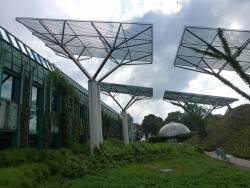- August 24, 2016
- Posted by: Catalyst
- Category: Business Energy News

Lodge Farm in north Wales generates 150 kilowatt hours per day for the grid, and does so in an interesting manner. The power comes from the slurry of 300 brown Swiss and Norwegian red cattle, mixed in with chicken litter that cannot be fed to animals and waste from the local Kellog’s factory.
Beginning in 2011, the organic farm’s £750,000 anaerobic co-digester (AD) has since generated more than 4.5m kWh of commercial electricity and heat for the farmhouse, an on-site engineering works and 80-100 other homes.
“But I am not turning the farm into a rural power station. My job is to grow food,” says farmer Richard Tomlinson, who co-founded one of Britain’s largest organic milk co-operatives.
Mr Tomlinson says generating renewable power from farm food and waste makes ecological and financial sense. Nearly 110m tonnes of organic waste is produced in the UK per year, 90m of which comes from farms. An additional 10m tonnes of food waste is also produced, most of which goes straight into landfill.
“Combining the two waste streams to produce heat, electricity and fertiliser closes the loop. It doesn’t make any sense for the slurry to move off the farms or for food to be landfilled. It makes much more sense to bring food waste here too and put it through the digester,” says Tomlinson, who designed and built eight other farm-scale AD plants along with his brother.
The reality however, is that many of Britain’s 208 anaerobic digestion plants take up valuable farmland and use waste that could be fed to people or animals.
Because farm slurry is less efficient as food than other crops, many farmers have moved to growing maize to feed the digesters. The NFU estimates that around 15,000 hectares have been converted to maize just to feed the digesters.
There is a huge food waste crisis in Britain, costing businesses hundreds of millions each year in incineration and landfill fees. According to the Waste Resources Action Programme (Wrap), it is also mostly aviodable.
“Anaerobic digestion is the best option for anything that cannot be used to feed animals or people,” says Tristram Stuart, who started food waste campaign group Feedback. “But sending food waste into an AD plant only recovers a fraction of the energy that went into growing the food in the first place. Recycling tomatoes in this way, for example, generates less than 1% of the energy used to produce the crop. By contrast it’s up to 500 times better for the environment to divert food waste to pigs rather than sending it to AD. Pigs eat our waste, we eat pigs: it’s a virtuous circle.”
There should be a bright future for AD, with backing from the government and more food waste available for new plants. Scotland has seen the fastest growth, with anaerobic digestion trade body Adba saying that 27 projects are now up and running, with 43 more achieving planning approval and 12 others on the waiting list.
Unfortunately, England is far behind when it comes to separating food from other waste, and the government is also considering cutting electricity generation subsidies from future AD plants with a capacity over 500MW. The result, the industry says, is that less food waste will be saved for energy.
“Ignoring the benefits of supporting renewable electricity growth now creates real risks. AD can deliver the same, vital baseload electrical capacity as new nuclear, but cheaper and faster than Hinkley Point C,” says Adba’s chief executive, Charlotte Morton.
“We throw a shocking amount of food waste into landfill because we have not collected it and treated it separately. There is an overwhelming economic and environmental case for doing so. The collection of food waste can play a significant part in helping the UK achieve its 2020 recycling targets,” says Fergus Healy, food waste and AD director at the energy company Olleco.
If you would like to discuss any aspect of taking an Anaerobic Digestion plant from concept to reality please Contact Us or review our portfolio of Anaerobic Digestion Plant Case Studies.
